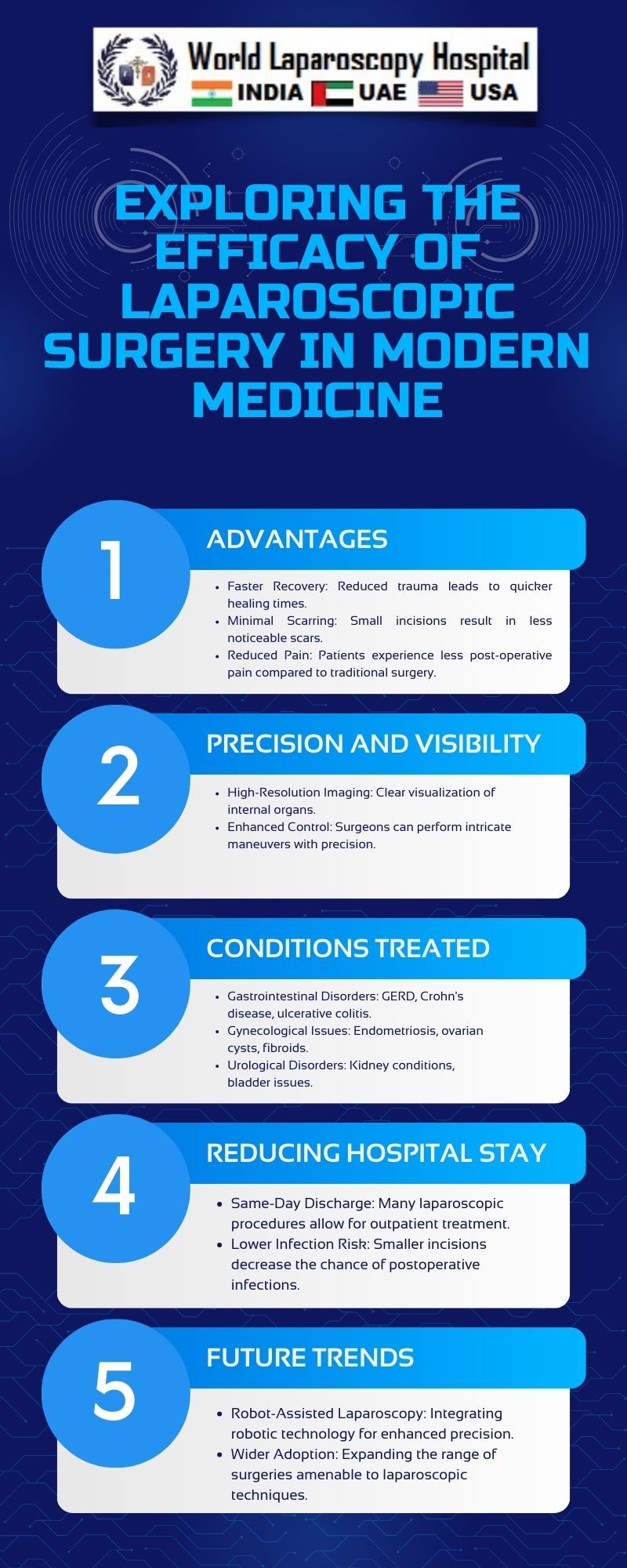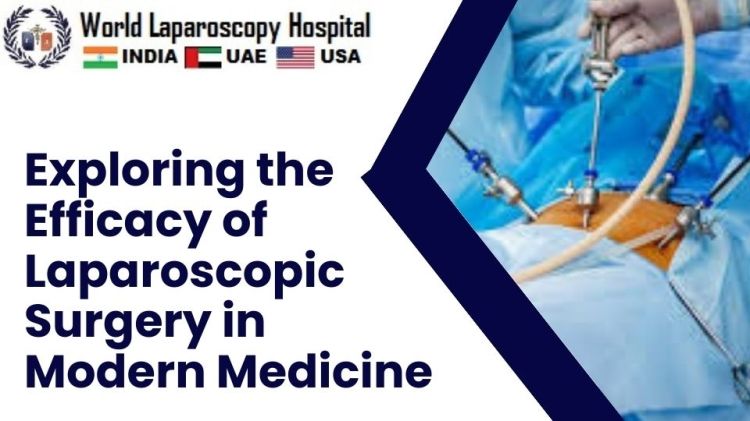Exploring the Efficacy of Laparoscopic Surgery in Modern Medicine
Introduction:
In the ever-evolving landscape of modern medicine, laparoscopic surgery stands as a testament to technological advancements that have transformed traditional medical practices. This minimally invasive technique, also known as keyhole surgery, has garnered widespread acclaim for its efficacy across various medical disciplines. This article delves into the multifaceted aspects of laparoscopic surgery, examining its historical roots, technological innovations, procedural applications, and the far-reaching impact it has on patient outcomes and the healthcare landscape.

Historical Evolution of Laparoscopic Surgery:
To understand the current significance of laparoscopic surgery, it is crucial to trace its historical evolution. The roots of minimally invasive surgery can be traced back to the early 20th century, with the development of cystoscopy and thoracoscopy. However, it wasn't until the late 20th century that laparoscopic techniques gained prominence in abdominal surgeries.
The pivotal moment in the history of laparoscopy was the introduction of the laparoscope by Georg Kelling in 1901 and the subsequent work of Hans Christian Jacobaeus in 1910. These early developments paved the way for the exploration of abdominal cavities without resorting to large incisions, laying the foundation for the transformative changes to come.
Technological Innovations Driving Laparoscopic Surgery:
The success and widespread adoption of laparoscopic surgery are intricately linked to technological innovations. One of the key components is the laparoscope itself, a slender tube equipped with a camera and light source, allowing surgeons to visualize the internal organs with unprecedented clarity. Over the years, advancements in optics, camera technology, and image processing have significantly enhanced the quality of visual information available during laparoscopic procedures.
Additionally, the development of specialized instruments designed for precise manipulation in confined spaces has been instrumental in expanding the scope of laparoscopic surgery. These instruments, with features such as articulated tips and ergonomic handles, enable surgeons to replicate the dexterity of traditional open surgery in a minimally invasive setting.
Procedural Applications Across Medical Disciplines:
Laparoscopic surgery's versatility is evident in its applications across a spectrum of medical disciplines. Gastrointestinal surgeries, including appendectomies, cholecystectomies, and colorectal procedures, have witnessed a paradigm shift with the adoption of laparoscopic techniques. The benefits extend beyond general surgery to specialized fields such as urology, gynecology, and even cardiovascular surgery.
Gastrointestinal Surgeries:
Cholecystectomy:
The removal of the gallbladder, once a major open surgery, has become routine through laparoscopic cholecystectomy. Patients experience reduced postoperative pain, shorter hospital stays, and quicker recovery.
Appendectomy:
Laparoscopic appendectomy is now the standard of care for acute appendicitis, offering advantages like minimal scarring and lower rates of postoperative complications.
Colorectal Procedures:
Laparoscopic colorectal surgeries have shown promising results in treating conditions like colorectal cancer, diverticulitis, and inflammatory bowel disease. Patients benefit from smaller incisions, decreased pain, and faster return to normal activities.
Urological Procedures:
Nephrectomy:
Laparoscopic nephrectomy, the removal of a kidney, has become a preferred approach, especially in cases of living kidney donation. The minimally invasive nature reduces donor morbidity and accelerates recovery.
Prostatectomy:
Prostatectomy for the treatment of prostate cancer has evolved with the introduction of laparoscopic techniques, offering reduced blood loss, shorter hospital stays, and improved outcomes compared to open surgery.
Gynecological Surgeries:
Hysterectomy:
Laparoscopic hysterectomy has transformed the landscape of gynecological surgeries, providing a less invasive alternative for conditions like uterine fibroids and endometriosis. Patients experience less pain, decreased scarring, and quicker recovery.
Ovarian Cystectomy:
Laparoscopic removal of ovarian cysts is a common procedure in gynecology, offering the advantages of minimal scarring, reduced postoperative pain, and faster return to normal activities.
Advantages and Challenges of Laparoscopic Surgery:
The widespread adoption of laparoscopic surgery is attributed to its numerous advantages, but it is not without challenges.
Advantages:
Minimally Invasive:
The hallmark of laparoscopic surgery is its minimally invasive nature, resulting in smaller incisions, less trauma to surrounding tissues, and reduced postoperative pain.
Faster Recovery:
atients undergoing laparoscopic procedures often experience shorter hospital stays and quicker recovery times compared to traditional open surgery.
Reduced Blood Loss:
The precision of laparoscopic instruments contributes to minimal blood loss during surgery, reducing the need for transfusions and associated complications.
Cosmetic Benefits:
Smaller incisions lead to reduced scarring, providing cosmetic benefits and addressing aesthetic concerns for patients.
Lower Infection Rates:
With smaller incisions and reduced exposure of internal organs to the external environment, laparoscopic surgery is associated with lower infection rates.
Challenges:
Learning Curve:
Mastering laparoscopic techniques requires specialized training and a steep learning curve for surgeons. Achieving proficiency in manipulating instruments in a three-dimensional space can be challenging.
Equipment Costs:
The initial costs associated with laparoscopic equipment and technology can be significant, posing financial challenges for healthcare institutions, especially in resource-limited settings.
Limited Tactile Feedback:
Unlike open surgery, laparoscopic procedures lack direct tactile feedback, and surgeons must rely on visual cues. This absence of tactile sensation can be a limitation, especially in intricate surgeries.
Patient Selection:
Not all patients are suitable candidates for laparoscopic procedures, and factors such as obesity, previous surgeries, and certain medical conditions may limit its applicability.
Future Directions and Innovations:
As technology continues to advance, the future of laparoscopic surgery holds exciting possibilities. Emerging technologies like robotics are being integrated into laparoscopic procedures, offering enhanced precision and maneuverability. Virtual reality (VR) and augmented reality (AR) are also being explored to provide surgeons with immersive visualizations, potentially addressing the limitation of limited tactile feedback.
Furthermore, research into new materials for laparoscopic instruments and advancements in energy sources for tissue cutting and sealing aim to further refine the surgical experience. Artificial intelligence (AI) applications in laparoscopic surgery, such as image recognition and assistance in decision-making, hold promise for improving surgical outcomes.
Conclusion:
Laparoscopic surgery has undoubtedly revolutionized modern medicine, offering a less invasive alternative to traditional open procedures across various medical specialties. The historical journey from early innovations to the current state of laparoscopic surgery reflects a relentless pursuit of improved patient outcomes, reduced morbidity, and enhanced surgical precision.
As the field continues to evolve, addressing challenges and embracing innovations will be crucial. The ongoing integration of robotics, virtual reality, and artificial intelligence signals a dynamic future for laparoscopic surgery, promising further refinements in technique, expanded applications, and ultimately, improved healthcare delivery for patients worldwide.
